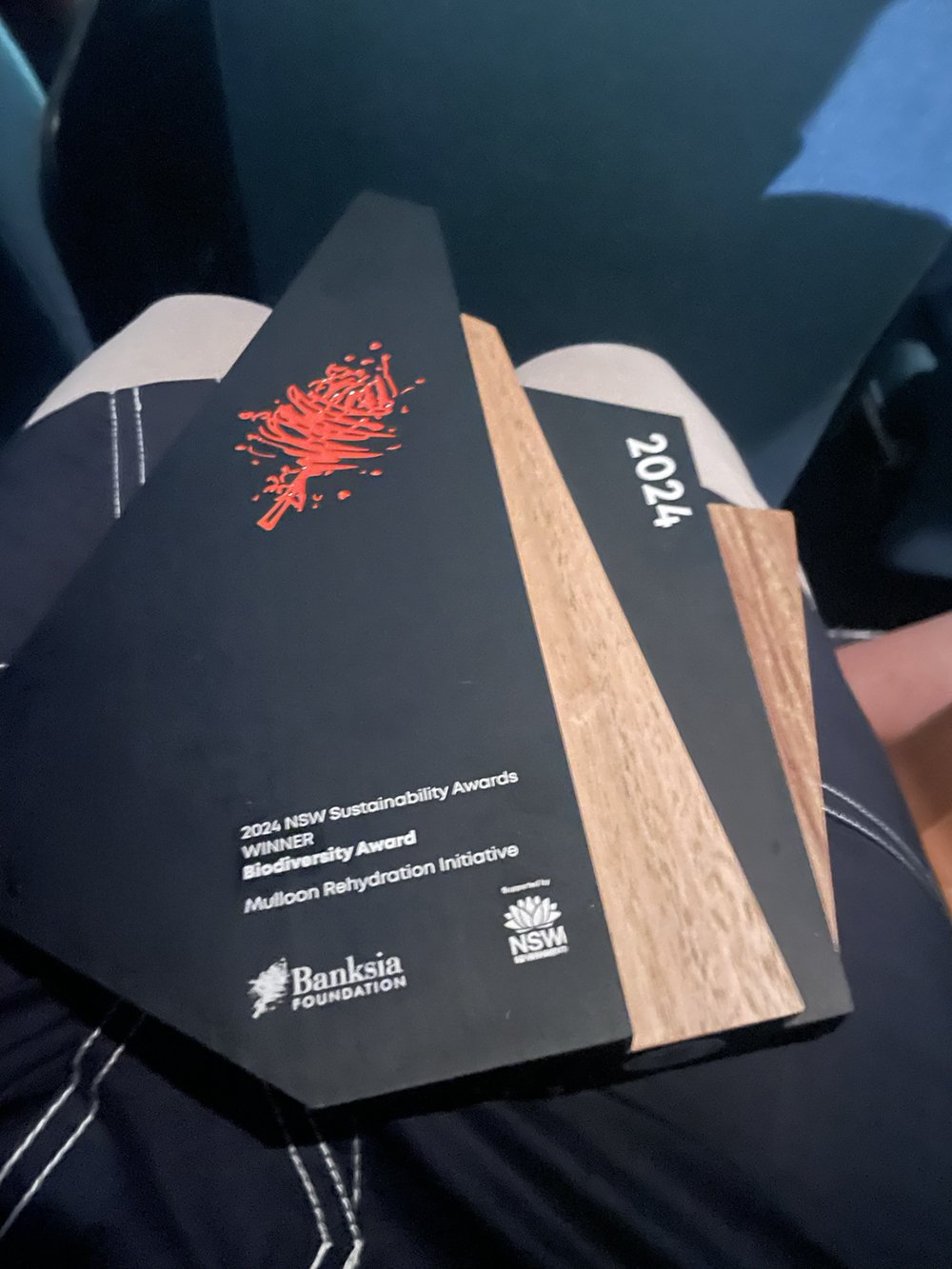Mulloon Institute Board L-R: Wilf Finn, Carolyn Hall (CEO & MD) and Matt Egerton-Warburton (Chair).
We are thrilled to announce… the Mulloon Rehydration Initiative has WON the BIODIVERSITY category in the Banksia NSW Sustainability Awards, 2024!
This prestigious award celebrates achievements in conservation, habitat restoration and species protection. It recognises individuals, organisations and initiatives leading the way in sustainable management practices, ecosystem rehabilitation, and innovative research and technology for preserving biodiversity.
Mulloon Institute’s Matt Egerton-Warburton, Carolyn Hall (CEO & MD) and Wilf Finn were on hand to receive the award from Trish Doyle, Parliamentary Secretary for Climate Change, the Environment and Heritage in Sydney on Friday 15 November.
This win is a significant honour, reflecting Mulloon Institute’s unwavering dedication to environmental regeneration and education through our landscape rehydration programs. We are deeply grateful to everyone who shares this journey with us, who believes in us, who works with us, who supports us and helps us amplify our message of hope.
Congratulations to our fellow finalists for their outstanding contributions, it is an incredibly strong field of competitors to be standing alongside:
-
Australian Museum’s FrogID Project that is vital for monitoring native frog populations, helping scientists track environmental changes and preserve biodiversity. By engaging the public in citizen science, it enhances awareness and protection of vulnerable ecosystems across Australia. Mulloon Institute uses and promotes the Frog ID Project as a valuable biodiversity resource across Australia; and
-
Broger’s End, Kangaroo Valley which supports biodiversity through habitat conservation, sustainable farming, and native vegetation restoration, creating a thriving environment for local wildlife and healthier, more resilient ecosystems.
And a BIG thank you to the Banksia Foundation and judges. This recognition at these 2024 NSW Banksia Sustainability Awards builds on our story of hope, attracting increased visibility to our work, and opens doors to new partnerships, collaborations and expanded funding opportunities.
The Mulloon Rehydration Initiative (MRI) is the Mulloon Institute’s flagship project in southern New South Wales. It is rebuilding the functionality and resilience of the Mulloon catchment, its riparian corridor, tributaries, floodplains, wetlands, hills and woodlands, and is forming a critical biodiversity corridor in the region.
This recognition would not have been possible without the outstanding contribution of our Principal Landscape Planner, Peter Hazell, who has been the cornerstone of the catchment project since its inception in 2011, alongside our Founders, Tony and Toni Coote. We are deeply grateful to the MRI landholders, whose enthusiastic participation has been integral to the success of this project.
We also acknowledge the advice from Yuin knowledge holder Greg Smart from Back to Country who recently said, “what we do to Country, we do to ourselves”. The MRI has taken enormous steps to heal Country, restore biodiversity back to the landscape, returning water to the floodplain, and has made Mulloon Creek Natural Farms more productive and more resilient to drought, bushfire and flood.
The evidence-based success of the Mulloon Rehydration Initiative now places the project in a position to be scaled up and rolled out across different ecosystems across the nation. We already have catchment projects underway in Western Australia’s Wheatbelt region, and the central desert rangelands in Northern Territory. You can read more with our Case Studies.
This is a real opportunity for New South Wales to lead the nation with a restoration economy.
The MRI has provided a story of hope, of what can be achieved when grassroots rural communities come together and aspire to make change in how their landscapes function and how they manage their landscapes. It has shown communities that catchment-scale projects are possible, that funding can be found, and that support from natural resource managers, regulators, scientists, and politicians can coalesce around participatory projects. It demonstrates how rural communities can deliver a better future that combines safeguarding the richness of nature, with sustainable and financially productive agriculture and adaption to climate change.
Special thanks to the National Maritime Museum for sponsoring the Biodiversity Award.


